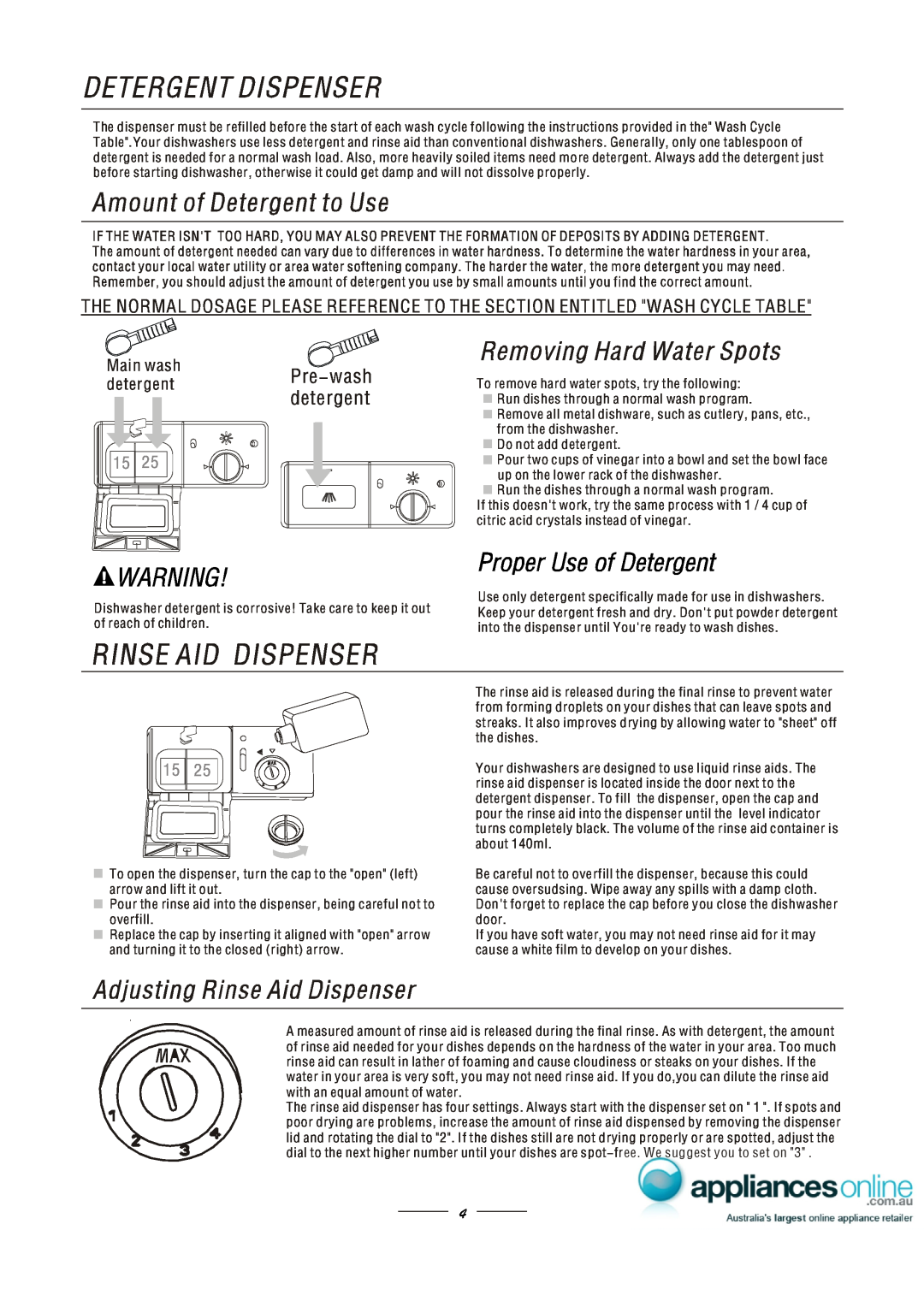
The dispenser must be refilled before the start of each wash cycle following the instructions provided in the" Wash Cycle Table".Your dishwashers use less detergent and rinse aid than conventional dishwashers. Generally, only one tablespoon of detergent is needed for a normal wash load. Also, more heavily soiled items need more detergent. Always add the detergent just before starting dishwasher, otherwise it could get damp and will not dissolve properly.
THE NORMAL DOSAGE PLEASE REFERENCE TO THE SECTION ENTITLED "WASH CYCLE TABLE"
Main wash |
| |
detergent | ||
detergent | ||
|
15 ![]()
![]() 25
25
To remove hard water spots, try the following:
![]() Run dishes through a normal wash program.
Run dishes through a normal wash program.
![]() Remove all metal dishware, such as cutlery, pans, etc., from the dishwasher.
Remove all metal dishware, such as cutlery, pans, etc., from the dishwasher.
![]() Do not add detergent.
Do not add detergent.
![]() Pour two cups of vinegar into a bowl and set the bowl face up on the lower rack of the dishwasher.
Pour two cups of vinegar into a bowl and set the bowl face up on the lower rack of the dishwasher.
![]() Run the dishes through a normal wash program.
Run the dishes through a normal wash program.
If this doesn't work, try the same process with 1 / 4 cup of citric acid crystals instead of vinegar.
Dishwasher detergent is corrosive! Take care to keep it out of reach of children.
Use only detergent specifically made for use in dishwashers. Keep your detergent fresh and dry. Don't put powder detergent into the dispenser until You're ready to wash dishes.
| The rinse aid is released during the final rinse to prevent water |
| from forming droplets on your dishes that can leave spots and |
| streaks. It also improves drying by allowing water to "sheet" off |
| the dishes. |
15 25 | Your dishwashers are designed to use liquid rinse aids. The |
| rinse aid dispenser is located inside the door next to the |
detergent dispenser. To fill the dispenser, open the cap and pour the rinse aid into the dispenser until the level indicator turns completely black. The volume of the rinse aid container is about 140ml.
To open the dispenser, turn the cap to the "open" (left) arrow and lift it out.
Pour the rinse aid into the dispenser, being careful not to overfill.
Replace the cap by inserting it aligned with "open" arrow and turning it to the closed (right) arrow.
Be careful not to overfill the dispenser, because this could cause oversudsing. Wipe away any spills with a damp cloth. Don't forget to replace the cap before you close the dishwasher door.
If you have soft water, you may not need rinse aid for it may cause a white film to develop on your dishes.
A measured amount of rinse aid is released during the final rinse. As with detergent, the amount of rinse aid needed for your dishes depends on the hardness of the water in your area. Too much rinse aid can result in lather of foaming and cause cloudiness or steaks on your dishes. If the water in your area is very soft, you may not need rinse aid. If you do,you can dilute the rinse aid with an equal amount of water.
The rinse aid dispenser has four settings. Always start with the dispenser set on " 1 ". If spots and poor drying are problems, increase the amount of rinse aid dispensed by removing the dispenser lid and rotating the dial to "2". If the dishes still are not drying properly or are spotted, adjust the dial to the next higher number until your dishes are
4
